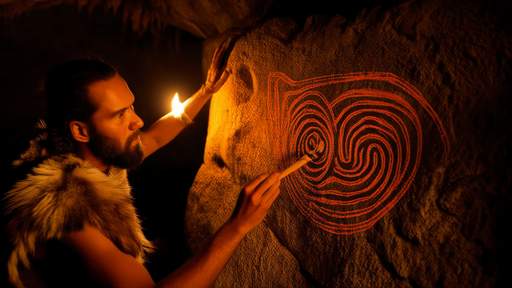In the heart of Jerusalem, where history is etched into every stone, archaeologists have unearthed a remarkable treasure that is shedding new light on the city's ancient past. The discovery of two 2,300-year-old gold rings, each adorned with a striking red gemstone, has captivated the world of archaeology and rewritten the narrative of Jerusalem's Hellenistic period. These exquisite artifacts, found at the City of David site in the Jerusalem Walls National Park, are more than just beautiful relics; they are keys to understanding a bygone era.
The two rings, small enough to fit a child's finger, were discovered in the foundations of a large building, buried in a layer of dirt dated to the late third or early second century BC. Alongside them, researchers uncovered bronze earrings, a gold earring resembling a horned animal, and a decorated gold bead. These treasures, collectively, paint a vivid picture of the wealth and sophistication of Jerusalem's residents during the Early Hellenistic Period, which lasted from 332 to 141 BC.
The Significance of the Discovery
The Hellenistic period, marked by the spread of Greek culture and influence, was a time of significant transformation in Jerusalem. Until now, this era was primarily known through ancient texts, with little archaeological evidence to support the accounts. The discovery of these gold rings and other artifacts is a game-changer, providing tangible proof of the city's affluence and cultural richness.
Efrat Bocher, an excavation manager from Bar-Ilan University and the Center for the Study of Ancient Jerusalem, emphasized the rarity of such findings. "This displayed wealth is very rare in any archaeological layer, and it attests to the wealth of Jerusalem and the high standard of living of the city's residents during this period," she said in a statement. The discovery challenges previous assumptions that Jerusalem was a culturally isolated and economically modest city during this time.
The Rings and Their Origins
The newfound gold ring, set with what appears to be a garnet, was in such excellent condition that excavators initially mistook it for a modern piece of jewelry. Rivka Lengler, one of the first archaeologists to examine the artifact, recognized its ancient design and alerted the rest of the team. "When I held this ring in my hand, I felt that I could actually touch and connect with the people who lived here thousands of years ago," she said.
The second ring, discovered less than a year ago, is similarly adorned with a red gemstone and shows no signs of age. Both rings are small, fitting a woman's pinkie finger at most, but more likely a girl's finger. Dr. Marion Zindel, an archaeologist with the Israel Antiquities Authority, analyzed the rings and believes they were crafted by hammering thin gold leaf onto metal ring bases. The meticulous craftsmanship suggests a high level of skill and artistic finesse.
The Ritual Significance
The placement of these rings and other jewelry beneath the building's floors suggests an intentional burial. One hypothesis is that the jewelry was used in a Hellenistic period custom where betrothed women would bury their childhood objects, including jewelry, in the house foundations as a symbol of their transition from childhood to adulthood. This ritual, previously known from texts, has now been corroborated by archaeological evidence.
The trend of combining colorful gems with gold was influenced by Indian and Persian fashion, brought to the region by Alexander the Great's eastern conquests. These conquests opened trade channels, transporting luxury goods between various regions and enriching the cultural tapestry of Jerusalem.
A New Understanding of Jerusalem's Past
The discoveries at the City of David site are rewriting the narrative of Jerusalem's Hellenistic period. Previously, experts believed the city was culturally isolated, rejecting outside influences based on ancient texts. However, the jewelry and associated customs suggest that Jerusalem's inhabitants were open to adopting Hellenistic cultural trends, lifestyle, and architecture.
Dr. Yiftah Shalev, an archaeologist at the Israel Antiquities Authority, and Yuval Gadot, head of the Sonia & Marco Nadler Institute of Archaeology and professor of archaeology at Tel Aviv University, have led the excavations. They are eager to gain a better understanding of Jerusalem between the first and ninth centuries BC, a period that has been missing from the archaeological record.
The excavations, conducted jointly by the Israel Antiquities Authority and Tel Aviv University, have uncovered an entire neighborhood, including domestic and administrative buildings that extended westward from the City of David hilltop. This discovery challenges the assumption that Jerusalem was a small town during this era, revealing instead a thriving urban center.
Future Research and Implications
The team plans to analyze animal bones, coins, and pottery recovered from the site to learn more about interregional connections, the origin of imported goods, and even the culinary habits of Jerusalem's inhabitants. The bones could reveal whether the residents practiced Kashrut regulations, or kosher Jewish dietary laws, which govern what animals could be consumed and how they should be prepared and handled.
As researchers continue to study these artifacts, they hope to gain a deeper understanding of Jerusalem's position during the Hellenistic period. With the Temple at one end and the Hellenic cultural presence at the other, the city was a melting pot of traditions and influences. "We are only now beginning to explore the story of 4th-2nd century BCE Jerusalem," Gadot said in an email. "With the Temple at one end and the Hellenic cultural presence at the other, we want to understand the position of the people living in Jerusalem."
The discovery of the gold rings and other artifacts at the City of David site is a testament to the enduring power of archaeology to uncover hidden histories. These treasures, buried for millennia, have emerged to reveal a Jerusalem that was wealthy, cosmopolitan, and deeply connected to the broader Hellenistic world. As researchers continue to analyze these finds, they will not only enrich our understanding of the past but also inspire a new generation to explore the rich tapestry of human history.

By Daniel Scott/Jun 6, 2025

By John Smith/Jun 6, 2025

By Daniel Scott/Jun 6, 2025

By Emma Thompson/Jun 6, 2025

By Sophia Lewis/Jun 6, 2025

By Olivia Reed/Jun 6, 2025

By Joshua Howard/Jun 6, 2025

By David Anderson/Jun 6, 2025

By Emma Thompson/Jun 6, 2025

By Emily Johnson/Jun 6, 2025

By Samuel Cooper/Jun 6, 2025

By Emily Johnson/Jun 6, 2025

By Sophia Lewis/Jun 6, 2025

By Jessica Lee/Jun 6, 2025